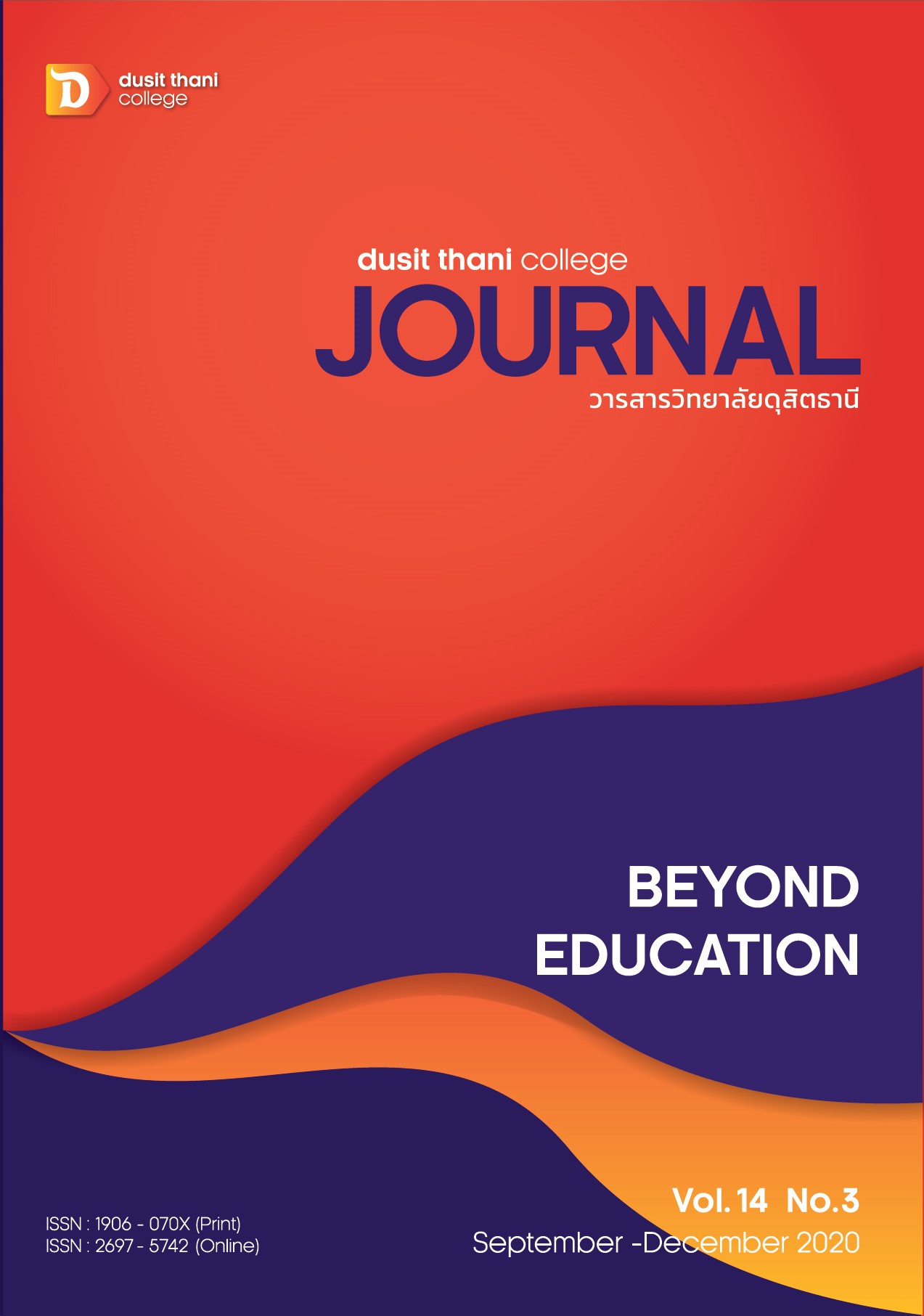ปัจจัยตัวขับเคลื่อนคุณค่าด้านความแตกต่างของนักท่องเที่ยวผู้สูงอายุชาวต่างชาติที่มีต่อโรงแรมขนาดกลางและเล็ก
Main Article Content
บทคัดย่อ
งานวิจัยนี้มีวัตถุประสงค์เพื่อศึกษาองค์ประกอบของตัวขับเคลื่อนคุณค่าด้านความแตกต่างของนักท่องเที่ยวผู้สูงอายุที่มีต่อการเลือกใช้บริการโรงแรมขนาดกลางและเล็ก กลุ่มตัวอย่างคือ นักท่องเที่ยวผู้สูงอายุชาวต่างชาติ จำนวน 384 คน ที่เดินทางเข้ามาท่องเที่ยวและเคยมีประสบการณ์เข้าพักในโรงแรมขนาดกลางและเล็กในประเทศไทย โดยใช้แบบสอบถามชนิดมาตรวัดแบบลิเคอร์ท 7 ระดับเพื่อใช้วัดความคาดหวังของนักท่องเที่ยวผู้สูงอายุที่มีต่อการเลือกใช้บริการโรงแรมขนาดกลางและเล็ก จากการวิเคราะห์องค์ประกอบเชิงสำรวจ พบว่า องค์ประกอบของตัวขับเคลื่อนคุณค่าด้านความแตกต่างมีจำนวนทั้งสิ้น 4 องค์ประกอบ ได้แก่ 1) สุขภาพและความปลอดภัยที่ดีขึ้น 2) บรรยากาศการเข้าพักที่ดีขึ้น 3) การตอบสนองความต้องการที่ดีขึ้น และ 4) การเข้าถึงผู้ให้บริการได้ดีขึ้นและราคาที่สามารถจ่ายได้ ผู้ประกอบการโรงแรมขนาดกลางและเล็กสามารถนำผลการวิจัยไปใช้ในการพัฒนาผลิตภัณฑ์และการบริการให้มีความแตกต่างเพื่อสามารถตอบโจทย์ความต้องการของกลุ่มนักท่องเที่ยวผู้สูงอายุได้
Article Details
นโยบายการพิจารณากลั่นกรองบทความ
- บทความวิจัยและบทความวิชาการทุกเรื่องที่จะได้รับการตีพิมพ์ต้องผ่านการพิจารณากลั่นกรองโดยผู้ทรงคุณวุฒิ (Peer Review) ในสาขาที่เกี่ยวข้อง จำนวน 3 ท่าน/บทความ
- บทความ ข้อความ ภาพประกอบและตารางประกอบที่ลงตีพิมพ์ในวารสารเป็นความคิดเห็นส่วนตัวของผู้เขียน กองบรรณาธิการไม่จำเป็นต้องเห็นด้วยเสมอไป และไม่มีส่วนรับผิดชอบใด ๆ ถือเป็นความรับผิดชอบของผู้เขียนแต่เพียงผู้เดียว
- บทความที่จะได้รับการตีพิมพ์จะต้องไม่เคยตีพิมพ์ เผยแพร่ที่ใดมาก่อน และไม่อยู่ระหว่างการพิจารณาของวารสารฉบับอื่น หากตรวจสอบพบว่ามีการตีพิมพ์ซ้ำซ้อน ถือเป็นความรับผิดชอบของผู้เขียนแต่เพียงผู้เดียว
- บทความใดที่ผู้อ่านเห็นว่าได้มีการลอกเลียนหรือแอบอ้างโดยปราศจากการอ้างอิง หรือทำให้เข้าใจผิดว่าเป็นผลงานของผู้เขียน กรุณาแจ้งให้กองบรรณาธิการวารสารทราบจะเป็นพระคุณยิ่ง
เอกสารอ้างอิง
Batra, A. (2009). Senior pleasure tourists: examination of their demography, travel experience, and travel behavior upon visiting the Bangkok metropolis. International Journal of Hospitality & Tourism Administration, 10(3), 197-212.
Caber, M., & Albayrak, T. (2014). Does the importance of hotel attributes differ for senior tourists? A comparison of three markets. International Journal of Contemporary Hospitality Management, 26(4), 610-628.
Chan, E. S., & Wong, S. C. (2006). Hotel selection: When price is not the issue. Journal of Vacation Marketing, 12(2), 142-159.
Chen, W.-Y., Wang, K.-C., Luoh, H.-F., Shih, J.-F., & You, Y.-S. (2014). Does a friendly hotel room increase senior group package tourists' satisfaction? A field experiment. Asia pacific journal of tourism research, 19(8), 950-970.
Correia, S., & Elliott, R. (2006). An examination of Internet user profiles in the mature tourism market segment in South Africa. Consortium Journal of Hospitality & Tourism, 10(2).
Denny, M. (2009). The generations manifesto. The Undersea Journal, Second Quarter, 42-52.
Gunasekaran, N., & Anandkumar, V. (2012). Factors of influence in choosing alternative accommodation: A study with reference to Pondicherry, a coastal heritage town. Procedia-Social and Behavioral Sciences, 62, 1127-1132.
Hair, J. F., Black, W. C., Babin, B. J., & Anderson, R. E. (2010). Multivariate data analysis: Global edition. In: Pearson Higher Education Upper Saddle River, NJ.
Hartman, J. D., & Qu, H. (2007). The senior travel market: Do's and Don'ts. Journal of Quality Assurance in Hospitality & Tourism, 8(2), 67-81.
Huber, D., Milne, S., & Hyde, K. F. (2018). Constraints and facilitators for senior tourism. Tourism management perspectives, 27, 55-67.
Hudson, S. (2010). Wooing zoomers: marketing to the mature traveler. Marketing Intelligence & Planning, 28(4), 444.
Mohmed, B., Omar, S., & Tay, K. (2016). A Cohort Comparison of the Travel Preferences of Future and Golden Seniors in Penang Island. International Journal of Economics & Management, 10(1).
Moschis, G. P. (2003). Marketing to older adults: an updated overview of present knowledge and practice. Journal of Consumer Marketing, 20(6), 516-525.
Moschis, G. P., & Ünal, B. (2008). Travel and leisure services preferences and patronage motives of older consumers. Journal of Travel & Tourism Marketing, 24(4), 259-269.
Mungall, A., & Gherissi Labben, T. (2009). Hotel offer adjustments for senior citizen guests: perception of Swiss hoteliers. In Advances in Hospitality and Leisure (pp. 223-239): Emerald Group Publishing Limited.
National Statistical Office. (2015). The 2014 hotels and guest houses survey. Retrieved from http://web.nso.go.th/en/survey/construction/tourism_08.htm
Pallant, J. (2016). SPSS survival manual: McGraw-Hill Education (UK).
Radder, L., & Wang, Y. (2006). Dimensions of guest house service: Managers' perceptions and business travellers' expectations. International Journal of Contemporary Hospitality Management, 18(7), 554-562.
United Nations. (2015). World Population Aging 2015 – Highlights. Retrieved from https://www.un.org/en/development/desa/population/publications/pdf/ageing/WPA2015_Highlights.pdf
Victorino, L., Verma, R., Plaschka, G., & Dev, C. (2005). Service innovation and customer choices in the hospitality industry. Managing Service Quality: An International Journal, 15(6), 555-576.
Vieregge, M., Phetkaew, P., Beldona, S., Lumsden, S.-A., & DeMicco, F. J. (2007). Mature travelers to Thailand: A study of preferences and attributes. Journal of Vacation Marketing, 13(2), 165-179.
Vojvodic, K. (2015). Understanding the senior travel market: A review. Paper presented at the 3rd International Scientific Conference Tourism in Southern and Eastern Europe.
Wang, W., Wu, W., Luo, J., & Lu, J. (2017). Information technology usage, motivation, and intention: a case of Chinese urban senior outbound travelers in the Yangtze River Delta region. Asia pacific journal of tourism research, 22(1), 99-115.
Wuest, B., Emenheiser, D., & Tas, R. (2001). Is the lodging industry serving the needs of mature consumers? A comparison of mature travelers' and lodging managers' perceptions of service needs. Journal of Hospitality & Leisure Marketing, 8(3-4), 85-96.


